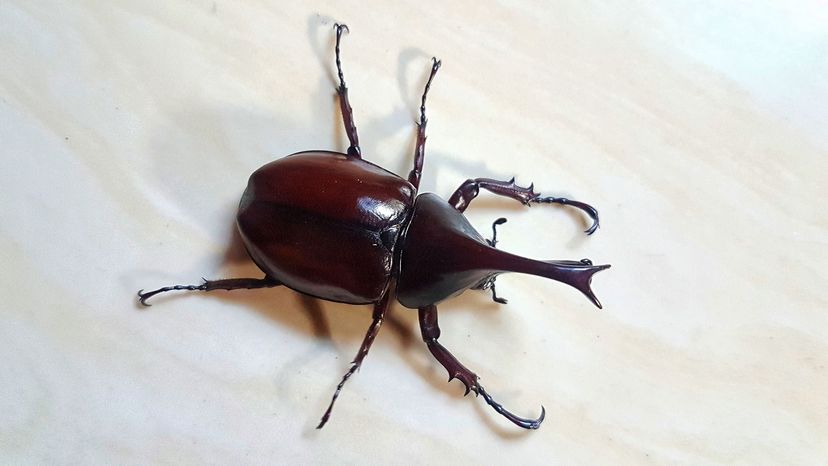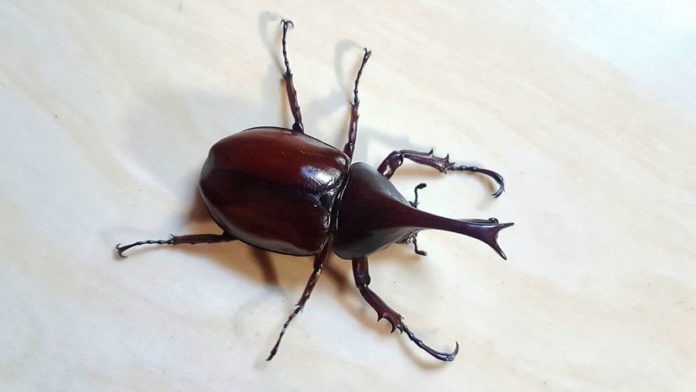 “You can always recognize a weevil by its long snout. Rizky Panuntun/Getty Images
“You can always recognize a weevil by its long snout. Rizky Panuntun/Getty Images
No one likes to see bugs in their pantry, much less think about them growing and multiplying among the foodstuffs. But that’s just what weevils are up to, when given the chance. Members of the family Curculionidae, weevils are actually beetles with some interesting upgrades. "Weevils that infest food items are tiny, but you can see their distinctive ‘beak-like’ snout jutting out from the head," says David Lofquist, region technical training manager at Arrow Exterminators in an email interview. In fact, the weevil’s mouthparts are located at the very end of this trademark snout.
However, with more than 3,000 species in North America alone, weevil size and appearance can vary pretty widely. They range in size from 0.10 inch (3 millimeters) to 0.25 inch (10 millimeters). But if you find insects inside bags of grains, beans or seeds, then weevils are the likely culprits.
"Commonly infested items are bird seed, pet food, or wildlife feed containing seeds or corn," says Lofquist. "Oftentimes, the infestation begins in the garage or basement and then spreads to a pantry." Typically, weevils are found in a product that has been stored for six months or longer, he adds. Although it’s possible to find adult beetles feasting on flour, it’s not likely, as they can’t use the flour to continue their life cycle. "That’s why identification is important because flour beetles or other scavenging type pantry pests may be the issue [instead]," he says.
How Do Weevils Get in Your Home?
Unfortunately for people who appreciate insect-free pantries, these little buggers like to infiltrate the area, but not in the way you might think. We already mentioned that infestation can start in the garage or basement, but that’s not the most likely cause.
"These pests usually come indoors via packaged foods or bulk products," says Ben Hottel, technical services manager for pest-control service Orkin. So, the odds of a weevil flying into the pantry are low, thankfully. It’s much more common to bring them home with you from the store.
Once weevils infiltrate the pantry, they can go undetected for quite a while. "Weevils lay eggs inside the kernels of grains or other starch products that are large enough for the larva to develop inside," Hottel explains. "Because the larva develops inside the kernels of grains, weevils can remain hidden in the pantry for a long time."
The weevil life cycle is pretty interesting, if also disgusting (considering food products are involved). First, female weevils deposit eggs on the surface of a grain, usually corn, rice, wheat, beans or peas. "When the larva hatches from the egg it will crawl over the grain until it finds a suitable opening and then burrow into the middle of the grain," says Terminix entomologist Angela M. Tucker in an email. "Once inside the grain, the larva will feed on the inside, develop and pupate (similar to a butterfly cocoon and not made of silk). The adult will emerge from the pupa stage, exit the grain, look for an adult of the opposite sex and the process starts again."
Are Weevils Harmful?
Now for the million-dollar question: Are weevils dangerous to humans? Fortunately, the answer is no. "They are not known for carrying pathogens which can result in illness," says Tucker. Even if you use products laden with weevil eggs, feces or (blech) molted skins, it won’t hurt you. "The cooking process takes care of any foodborne illness risk but most people will throw out infested items," says Hottel.
Getting Rid of Weevils
The first step is throwing out the dry pantry products that they favor. Pupae, larvae and eggs are super-tiny and usually hidden inside the grains, so don’t try to sift through and just remove adults. You’ll definitely miss some growing young weevils, and the cycle will perpetuate. Next, Lofquist says to thoroughly clean the pantry area, then store weevil-preferred foods in pest-proof containers. He suggests glass jars with tight-fitting lids.
Tucker cautions against relying solely on a bug spray to kill weevils. "There are products which are labeled for application to cabinets. I would not recommend using a residual liquid application as the adults can be physically removed and the immature stages will not be targeted as they are not moving in the cabinet space."
She adds that it’s important to inspect product packaging for signs of damage, such as holes, tears and webbing. Use your grain products sooner, rather than later, and store them in the refrigerator or freezer for best results
Sometimes, weevils can extend their reign of terror outside the pantry. "Weevils are especially long lived in their adult stage so it is common to see them wandering around the house for several months after the proper steps have been taken," Lofquist explains. "A vacuum cleaner is the best way to deal with these wayward adults."
If they persist, turn to the professionals. "Contacting a pest management professional can give homeowners peace of mind and confidence," Hottel says. "A technician will be able to identify the type of weevil present and create a specific treatment plan to rid the home of weevils."
Now That’s Gross
Although weevils prefer grains, they can also infest pasta, so be sure to store those in airtight containers as well.








































